
- Home
- Age
- Artist
- David Bates (3)
- David Snyder (4)
- F E. Jamieson (3)
- Francis E. Jamieson (3)
- Giovanni Demartino (3)
- Illegible Signature (10)
- Jean-michel Basquiat (3)
- John S. Barrows (4)
- Keith Haring (2)
- Lovejoy (3)
- Morgan (2)
- Mystery Artist (6)
- Otterman (3)
- Pablo Picasso (15)
- Remedios Varo (4)
- See Description (30)
- See Photos (3)
- Signed (4)
- Signed On The Back (2)
- Unknown (42)
- ... (4680)
- Maker
- American (4)
- Antique (5)
- Hand Made (8)
- Handcrafted (2)
- Handmade (7)
- Ideal (5)
- Jackson Bangar (6)
- Kutani (3)
- Lyons (2)
- Noh Mask (shakumi) (2)
- Old Hickory (3)
- Picasso (2)
- Primitive (2)
- Primitive Artisanal (2)
- Satsuma (2)
- Signed (2)
- The Kings Bay (3)
- Thomas Annett (2)
- Unknown (49)
- Unknown Crafter (3)
- ... (4715)
- Material
- Theme
- 1950s (8)
- Advertising (3)
- Art (6)
- Automobiles (5)
- Bakery & Baking (3)
- Banking & Insurance (10)
- Bar & Club (4)
- Bar & Club, Novelty (4)
- Breweriana (9)
- Buddha (5)
- Circus & Carnival (4)
- Dairy (3)
- Distillery (4)
- Floral (5)
- Gas & Oil (68)
- Halloween (5)
- Nature (5)
- Portrait (6)
- Soda (21)
- Tires (3)
- ... (4648)
- Type
- Acoustic (9)
- Baskets (9)
- Bowls (11)
- Boxes (46)
- Furniture (14)
- Kitchen Equipment (25)
- Marquee Sign (13)
- Metal & Ironwork (31)
- Painting (190)
- Paintings (14)
- Plaque (20)
- Plaques / Signs (18)
- Pottery (13)
- Print (22)
- Sculpture (13)
- Sign (45)
- Signs (76)
- Street Sign (19)
- Tools (11)
- Wooden Sign (9)
- ... (4221)
Antique Historic Old West Spanish California Mission SAN MIGUEL Wood Sign
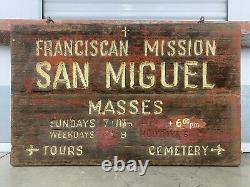
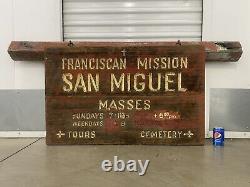
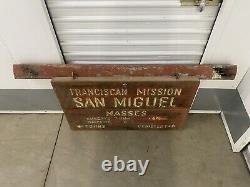
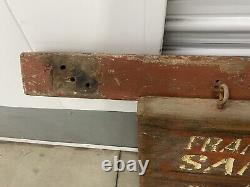
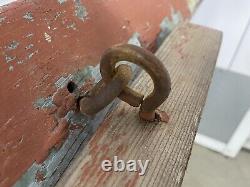
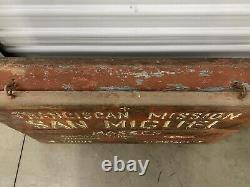
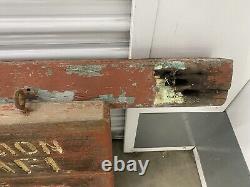
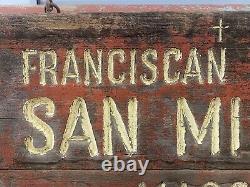

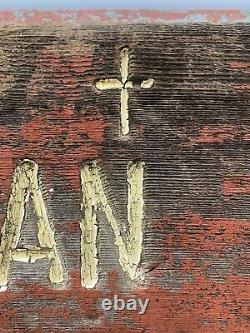
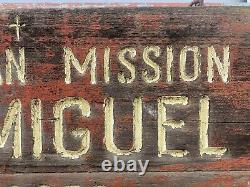

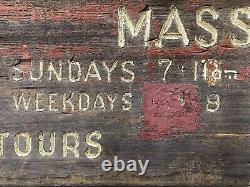
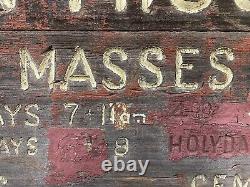
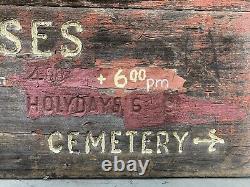




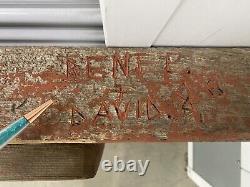


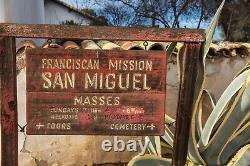
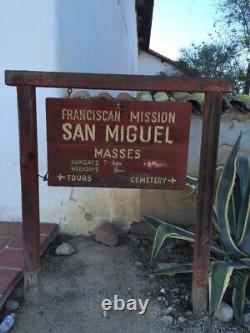


This is an original Antique Historic Old West Spanish California Mission SAN MIGUEL Wood Sign, which was formerly displayed at the Spanish Mission San Miguel Arcangel in San Miguel, California. The mission itself was established in 1797, and this sign appears to have been created and first used during the 1930's - 1940's. This sign was likely replaced sometime after a devastating 2003 earthquake, which damaged many areas of the main structure and surrounding buildings and temporarily closed the Mission to visitors for several years.
" Several words appear to be painted over, such as "HOLYDAYS. The sign itself is approximately 22 1/4 inches tall x 36 inches wide x 1 2/4 of an inch thick. The large cross bar that it hangs from is approximately 54 1/2 inches wide x 3 1/2 inches tall x 3 1/2 inches deep. Good overall condition for decades of age and outdoor display use, with an honest weathered patina, including paint loss and paint flaking, wood splitting, and an area of minor graffiti please see photos.Photos 23 & 24 show how the sign looked when it was hung in front of the old mission church. Acquired from an old collection in Southern California. Due the large size and heavy weight of this piece, S&H costs will be unavoidably high. If you like what you see, I encourage you to make an Offer. Please check out my other listings for more wonderful and unique artworks!
Mission San Miguel Arcángel is a Spanish Mission in San Miguel, California. It was established on July 25, 1797, by the Franciscan order, on a site chosen specifically due to the large number of Salinan Indians that inhabited the area, whom the Spanish priests wanted to evangelize. The mission remains in use as a parish church of the Diocese of Monterey. After being closed to the public for six years due to the 2003 San Simeon Earthquake, the church reopened on September 29, 2009.Inside the church are murals designed by Esteban Munras. The mission was put on the National Register of Historic Places in 1971. And was named to a National Historic Landmark in 2006. Of California's missions, it is one that retains more than most of its layout and buildings, including a portion of its neophyte village.
And Father Buenaventura Sitjar founded the mission on July 25, 1797, making it the sixteenth California mission. Its location between Mission San Luis Obispo. And Mission San Antonio de Padua.
Provided a stop on the trip that had previously taken two days. A temporary wooden church was built with living quarters. The site was chosen as it was close to a Salinan Indian village called Vahca. In 1798 the small chapel was replaced.
From 1816 to 1818 a new church was constructed with a tile roof and courtyard. The William Reed family lived in the buildings until 1848, when they were murdered by a band of thieves. The killers were tracked down by a posse in the foothills of Santa Barbara.Two thieves died in the ensuing battle, and the other three were tried and executed by firing squad. Upon secularization, the mission began to decay.
Padre Abella, the last Franciscan at San Miguel, died in July, 1841. But with the buildings in poor condition, no priests were assigned to the mission; buildings were rented to some small businesses.
In 1878 the Church reactivated the mission, and Rev. Philip Farrelly took up residence as First Pastor of Mission San Miguel.
The Mission Arcade, a series of 12 arches, is original. The variety of shapes and sizes was planned. And the Mission was known for this arcade. The first chapel on the site was replaced within a year of its construction by a larger adobe chapel, which burned in the 1806 fire.
The current mission church was built between 1816 and 1818. It is 144 feet (44 m) long, 27 feet (8.2 m) wide, and 40 feet (12 m) high. The cemetery adjacent to the church holds the remains of 2,249 Native Americans listed in the Mission's burial records.
The painted walls inside the church are the original artwork by artist Esteban Munras and other Salinan artists. Bells were vitally important to daily life at any mission. The Rios-Caledonia Adobe was built in 1835 just south of the San Miguel Mission as a home for the overseer of Mission lands. This historic site is well preserved with the original Inn and Stagecoach stop now a museum and small gift shop. A building was added in 1930 that is now a unique history research library. The grounds are maintained by San Luis Obispo County Parks with picnic sites and restrooms available. The Historic Rios-Caledonia Adobe is a California Historical Landmark (#936) and is listed on the National Park Service's National Register of Historic Places (#71000190).A Brief History of Mission San Miguel. Established as number 16 out of 21, Mission San Miguel has a unique feature: its interior murals, initially painted in the 1800s by Catholic Salinan Indians, have never been retouched or repainted. The Mission is a State and National Historic Landmark. Father Fermin Francisco de Lasuén selected the location for the Mission near the Salinas River to lessen travel between two Missions: Mission San Luis Obispo and Mission San Antonio. The mission was founded on July 25, 1797.
The mission's grounds extended 35 miles to the west, 66 miles to the east, and 18 miles to the north and south. The Mission's enormous footprint was used for growing crops, planting vineyards, raising cattle and sheep, and grazing horses and mules to trade and sustain their community.Mission San Miguel was intentionally located next to a Salinan Indian village called Vahca with a large population. Father Buenaventura Sitjar, the mission's first padre, had a relationship with the indigenous people, having ministered to them for twenty-five years at Mission San Antonio. In addition, father Sitjar spoke the Salinan people's language.
Ultimately, over 1,000 Salinan Indians would live and work at the Mission. In 1797, Salinan Indians began building a temporary church and other buildings at Mission San Miguel. A fire destroyed the church building, the other mission buildings, and all the harvested products in 1806. Planning and preparation for a new church began immediately following the fire. In the decade that followed, Salinan Indians made thousands of roof tiles and adobe bricks that were stored for constructing the new church.
In 1816 the foundation for the new church was laid, and by 1818, the new church was finished. The new church complex featured a long colonnade with numerous arches of varying shapes and sizes and six feet thick adobe walls. Monterey's Esteban Munras designed murals and completed the painting with the help of the Salinan Indians in 1821. These never-re-touched original murals make Mission San Miguel a special stop today along the California Mission chain. After Mexico won independence in 1821, life at Mission San Miguel changed.The Mexican government began the secularization of the mission system. Church property was converted to private property. Notably, the last group of missions to be secularized included Mission San Miguel. When the Mexican administrator took control of Mission San Miguel in 1834, only a few dozen Salinan Indians remained at the mission by this time, and no Spanish padres. In 1878 a newly assigned diocesan priest ran the mission and established a new parish.
On December 22, 2003, a severe earthquake struck California's Central Coast, the largest to hit the area in over fifty years. Located just 34 miles from the epicenter, Mission San Miguel was especially hard-hit. As a result, the whole Mission complex was closed to the public, and a campaign to raise funds for retrofitting began.In 2005, the Mission Gift Shop reopened, and then the Museum reopened at the end of 2006. Mission San Miguel is one of California's historical and cultural treasures. The beautiful old adobe building, whose foundations were laid more than 200 years ago, is a precious part of our heritage, with a story that is integral to California's history. Mission San Miguel - named for the Archangel Saint Michael - was founded by Franciscan Father Fermin Francisco de Lasuen in 1797 and was meant to close the gap between Mission San Antonio to the north and Mission San Luis Obispo to the south. Father Buenaventura Sitjar, who had ministered for years at Mission San Antonio and was fluent in the local Salinan language, baptized 25 youth on the day the Mission was established.
A temporary church was built in 1797 but was lost to fire in 1806 - at a time when more than 1,000 Salinans were living and working at the mission. Soon after the fire, preparations for a new adobe church began. Tiles and adobe blocks were made and stored before the stone foundation of the church was laid in 1816. By 1821 the church building was complete, along with the interior frescos designed by Esteban Munras. San Miguel Mission property extended 18 miles to the north and 18 miles to the south, 66 miles to the east and 35 miles to the Pacific Ocean.
The success of the Mission was due largely to Father Juan Martin who served here from the beginning until 1824. Following Mexico's move to independence, Mission San Miguel was secularized in 1834 and put under the control of a civilian administrator. With the exile of the Spanish Franciscans, the Salinan People left the mission for their ancestral homelands. On July 4, 1846, Petronillo Rios and William Reed took possession of the mission, and the Reed family occupied the recently abandoned buildings. After the 1848 murder of the Reed family members and their household staff, the mission rooms were converted to commercial stores such as a hotel, a saloon, and retail shops. In 1878 a diocesan priest was assigned, and the Parish of San Miguel was established. In 1928, Mission San Miguel was again occupied and administered by Franciscan Friars of the Province of Saint Barbara and continues so to this day. San Simeon Earthquake of 2003. On the morning of December 22, 2003, California's Central Coast was rocked by a severe earthquake, the largest to strike the region in over 50 years. Mission San Miguel, just 34 miles from the epicenter, was especially hard-hit. The entire Mission complex was closed to the public, and the long process for raising funds for a retrofitting began. In 2005, the Mission Gift Shop was reopened, and then on December 22, 2006 - the same day and time as the earthquake three years earlier - the Museum reopened. This was followed by reopening of the parish offices.On the Feast Day of St. Michael the Archangel on September 29, 2009, a dedication Mass was celebrated in the church and three days later a public ceremony was held to mark the church's reopening. In January and in October of 2011, retrofitting of the former retreat wing and part of the Franciscans' living quarters were completed. Two more wings of the inner quadrangle remain to be restored. Restoration fund raising continues today.
The church's appearance today is much the same as when it was built. The inside of the church has never been repainted. The wall frescos are the originals that were painted by Salinan artists under the direction of Esteban Munras. Today Mission San Miguel is both a State and National Historical Landmark, an authentic reminder of California's past.

